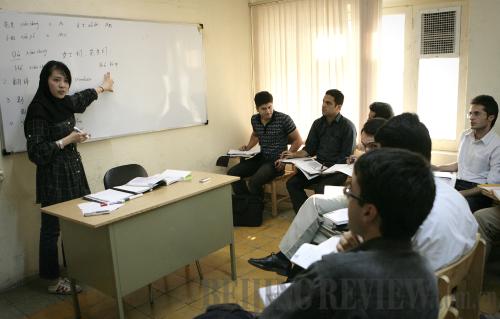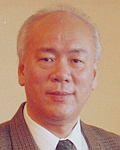|
 |
|
A NEW LANGUAGE: A volunteer from China teaches Chinese at the Confucius Institute of the University of Tehran on August 30, 2010 (XINHUA) |

This year marks the 40th anniversary of the establishment of diplomatic relations between China and Iran. Over the past four decades, Sino-Iranian relations have not only endured tests, but also made great strides. Since the beginning of the 21st century in particular, the two countries have developed strong political, economic and trade ties.
Early relations
In April 1970, a table tennis team from the United States visited China. Iran was one of the first nations to seize upon the information China and the United Stated would establish diplomatic relations through the game of ping-pong. In April 1971, Shah Mohammad Reza Pahlavi of Iran sent two Iranian princesses to visit China. They were warmly welcomed and became the first to explore the establishment of diplomatic relations between China and Iran.
In July 1971, U.S. National Security Advisor Henry Kissinger visited China. The improvement in Sino-U.S. relations brought resounding changes in international relations. The group of nations who had previously followed Washington in not establishing diplomatic relations with China collapsed rapidly. Iran was one of the earliest nations to take action. Following the release of the communiqué of Kissinger's visit to China, representatives from China and Iran started negotiating the establishment of diplomatic relations in Islamabad, Pakistan. On August 16, 1971, the two countries issued a communiqué announcing the establishment of diplomatic relations.
Following the visit of U.S. President Richard Nixon to China in 1972, China started to promote a united front—from the United States to Western Europe—against the Soviet Union. Iran was a crucial member of this alliance. It was obvious Iran was in an important place in Chinese diplomacy at that time. After the establishment of diplomatic relations between China and Iran, the relationship between these two countries warmed and high-level contacts hit a new peak. For instance, Iranian Empress Farah Pahlavi, accompanied by Prime Minister Amir-Abbas Hoveida, visited China in September 1972.
In 1978, a nationwide anti-Pahlavi movement erupted in Iran. In August that year, then Chinese leader Hua Guofeng visited Iran on his way back from visits to Romania and Yugoslavia. Hua was received well by the beleaguered shah. Less than half a year after this visit, the Pahlavi regime collapsed and the Islamic Republic of Iran was founded. Hua's visit was interpreted as Chinese support for the Pahlavi regime. Relations between the two countries suffered a severe setback.
Evolving ties
China established diplomatic relations with the United States in 1979, when the Islamic Revolution broke out in Iran. While China opened itself up to the rest of the world, Iran shifted from a highly Westernized country to a religious society. The United States and Iran ended their alliance, which had lasted for 30 years, and turned to hostilities. Sino-Iranian relations also chilled.
In November 1979, Iranian students occupied the Embassy of the United States in Tehran, and held U.S. diplomats hostage. The Iranian authorities vowed to export revolution, leaving a bad image on the international stage. Consequently, when Iraq's Saddam Hussein invaded Iran in September 1980, most countries sympathized with Iraq, and Iran became isolated. At that time, China was one of the few countries to take a neutral stance on the Iran-Iraq War.
In November 1984, Chinese Foreign Minister Wu Xueqian visited Iran. Relations between the two countries began to thaw.
After the Soviet Union disintegrated in 1991, the West mounted diplomatic and economic pressure on China. Despite its stable power transition after Iranian Supreme Leader Ruhollah Khomeini's death in 1989, Iran remained isolated on the international stage.
| 